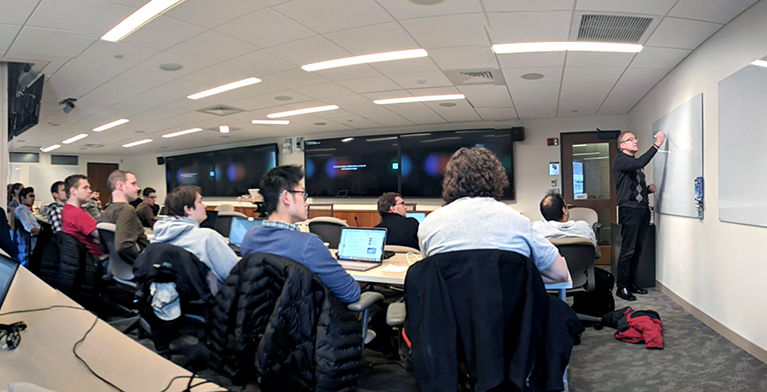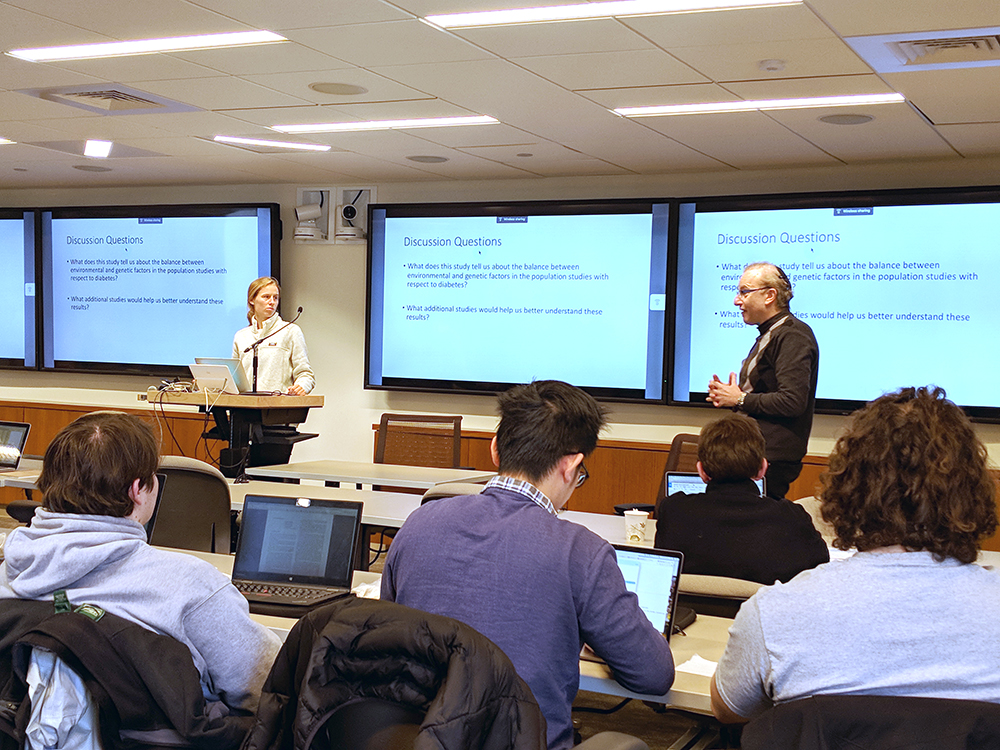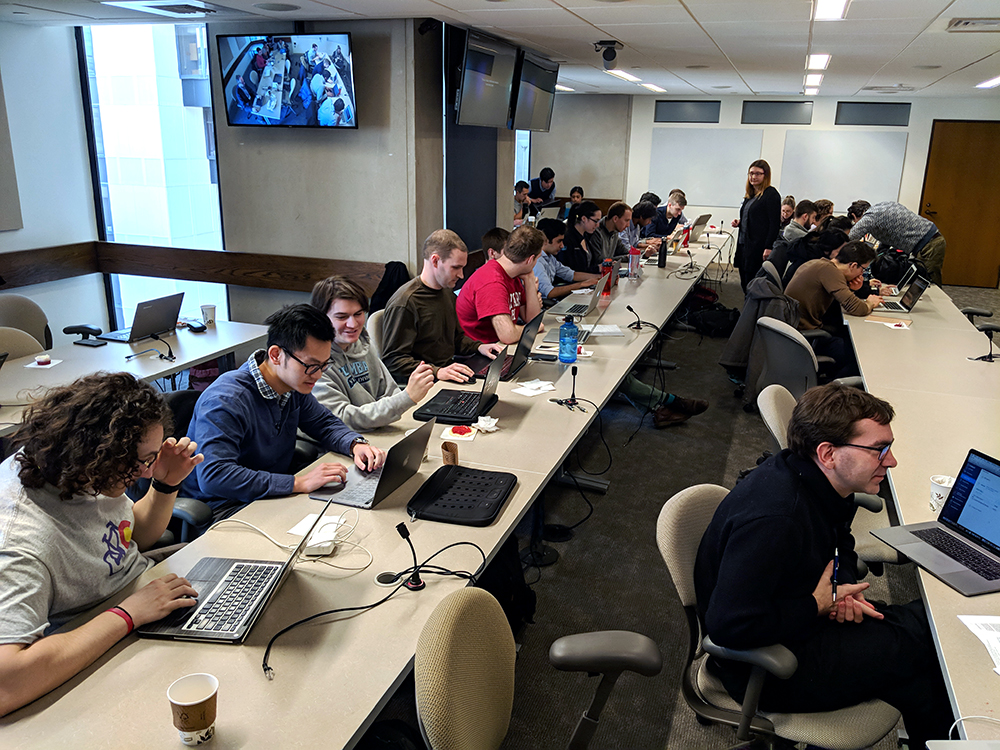
There was no sugarcoating the day’s topics.
What can data science tell us about the intelligence of Ashkenazi Jews? Can bioinformatics give us insights into how prehistoric human migrations have influenced genetic diseases today? What can data mining reveal about health disparities among different ethnicities?
More importantly, can these data—and their interpretation—be trusted?
Topics at the intersection of race and science may trigger controversial conversations, but for third-year Harvard Medical School students enrolled in HMS’s innovative new course on computationally-enabled medicine, these were necessary, if delicate, discussions.
“My hope for today is to show you that if you don’t have a certain mental hygiene about data science and computation, you can come to a lot of erroneous conclusions about the significance of race and ethnicity that can directly affect patient health,” course co-director Isaac Kohane, the Marion V. Nelson Professor of Biomedical Informatics, told the class.
“The AISCs are one of the most exciting things happening at HMS because students are at a new developmental point in their education,” — Edward Hundert, dean for medical education
Those students were taking a brand-new course, called an advanced integrated science course (AISC). Together, the eight AISCs currently offered embody a unique pedagogical approach that aims to provide medical students with the skills they need to evaluate new research advances and incorporate them into their clinical decision making as physicians. Every student must take two of these courses as a requirement for the MD degree in the HMS Pathways curriculum.
“The AISCs are one of the most exciting things happening at HMS because students are at a new developmental point in their education,” said Edward Hundert, dean for medical education and the Daniel D. Federman, M.D. Professor in Residence of Global Health and Social Medicine and Medical Education.
“They’ve learned quite a bit of medicine through their time on the wards. Now they are back in the classroom, guided by basic science faculty and clinician-scientists, exploring the boundaries between the known and the unknown in biomedicine,” Hundert said. “The goal is not to learn more clinical skills, but to learn more science in the service of patients.”
HMS launched Pathways, a paradigm-shifting redesign of the School’s medical education curriculum, in 2015, shifting the clerkship year at HMS-affiliated hospitals to students’ second year of school. This approach gives students the opportunity to gain clinical experience and develop relationships with patients and colleagues sooner than they would in a traditional curriculum. Then, armed with insights and questions from 12 months of intense clinical immersion, they can return to the classroom in their third year to take a deeper dive into biomedical research through the AISCs.
Team taught by HMS faculty drawn from both basic science departments on the Quad and HMS-affiliated hospitals, the AISCs cover current topics ranging from regenerative biomedicine to neurobiology to immunology. The courses are designed to teach students how to navigate the ever-changing landscape of scientific discovery while keeping mindful of its transformative effects in the clinic.

Connecting science and medicine
A deeper understanding of the power and pitfalls of computation and data in biomedical research was the primary goal for students taking Kohane’s course this winter on computationally enabled medicine, co-led by Paul Avillach, assistant professor of biomedical informatics and HMS assistant professor of pediatrics at Boston Children’s Hospital.
Emphasizing the flipped-classroom and active-learning approach utilized throughout the Pathways curriculum, students lead in-depth discussions during class. In this particular session on race and ethnicity in medicine, they broke down several research papers that used big data to claim insights on a variety of issues.
“Medicine is fundamentally an information- and data-processing discipline,” said Kohane, who is also chair of the Department of Biomedical Informatics. “How you distill data into knowledge, and how you take that knowledge and put it in practice, is at the heart of medical science today.”
Because students come to this course after their clinical experience, Kohane said, the material is much more relevant and understandable.
“Had they not had the clinical exposure they did, the questions that we ask, and the papers we cover, would be much less interesting and much less relevant,” he added.
“How you distill data into knowledge, and how you take that knowledge and put it in practice, is at the heart of medical science today.” — Isaac Kohane
The class debated the merits and deficiencies of studies that covered issues such as how statistical correlations between ethnicity and intelligence can fail to consider nuances in socioeconomic and environmental effects, how poorly designed control groups can skew the interpretation of genetic disease prevalence, and how using information from these types of studies to inform public health screening or individual patient care can be problematic.
“In our second year, we were full time in the hospital,” said Joe Tung, a third-year MD-MBA student from the Holmes Society. “But when you’re so immersed in every day clinical activities, you don’t have a chance to step back and reflect on the problems you’re seeing.”
“I feel like the AISCs are a way for us to have dedicated time to think more thoroughly about the problems we’ve encountered in the clinic and to gain tools for us to better assess and better work on solutions,” he said.
Like all the AISCs, Kohane and Avillach’s course asked students to raise questions and become active contributors to biomedical research, challenging them to develop practical skills inside the classroom and out.
In this course, some of that work involved building familiarity with computer science and programming, which allows students to more fully engage in areas that ranged from algorithms and artificial intelligence to electronic medical record workflow and health disparities.
“This class definitely opened my mind to different possibilities for the future of medicine,” said Kira Seiger, a third-year Pathways student from the Peabody Society.
“What kind of data sets do we have at our disposal, and how do we mine them effectively? Can we use these data to create new diagnoses, not just new treatments, to help patients who might have a form of a disease that may have been misclassified? There are so many interesting questions that large datasets allow us to explore,” she said.

Real World
All of the AISC faculty work closely with research or clinical partners to embed students in active research laboratory, clinical or industry sites. There they can begin to apply what they’ve learned in the classroom to their practical experiences.
In Kohane and Avillach’s month-long course, students spent two days a week with mentors at the managed health care company Aetna or Takeda Pharmaceuticals, working closely with research scientists on data and computation-intensive projects, such as drug candidate filter screens that help improve the development process and lower costs for patients.
Students in other AISCs are engaged in a wide range of projects, such as working with physicians who are running clinical trials, or even—in the case of an AISC on translational pharmacology—on developing new drugs for patients they encountered during their clinical clerkship year.
The timing of the AISCs—at least one is mandatory in each of the third and fourth years of the Pathways curriculum—was designed to help students as they progress through their medical education and develop specialty interests. All students at HMS are required to produce a scholarly project, and many students now use these AISCs in their third year to find research mentors and develop their project at a time in medical school when they have more clarity about their future career paths.
“AISCs are at the heart of a four-year medical curriculum that’s designed to train and nurture future physician-scientists and humanistic leaders, who can carry this research into their residencies and beyond,” Hundert said.
The AISCs represent the culmination of an innovative collaboration between basic science and clinical faculty across HMS. The courses were developed by faculty led by John Flanagan, professor of cell biology, Eli Miloslavsky, HMS assistant professor of medicine at Massachusetts General Hospital, and Henrike Besche, associate director of curriculum integration at HMS, with the support of chairs from all departments on the Quad.
“Science is increasingly complex and moving at such a rapid pace that, to be an exceptional physician in the coming decades, it’s a necessity to be able to understand research at the frontiers of medicine,” Flanagan said.
“Physicians have to incorporate new advances into their clinical care but also have to provide leadership in terms of directing research toward the most pressing clinical problems and unmet needs,” he added.
“There is no evidence-based medicine without research; they go hand-in-hand,” Flanagan said.


